The popularity of open-source eCommerce – thanks to the flexibility and safety it offers – has seen a flood of platforms hit the market in recent years. There are so many alternatives for opening up an online store and digitizing inventory… and each claims to have the best technology, feature set, dev community, and technical support. There are some fantastic open-source platforms out there but it’s hard to know which is right for your business. We’ve put together the ultimate resource to help you make the right decision. Here’s what you can expect:
- A list of 40 open-source eCommerce solutions
- An overview of 15 selected open-source eCommerce platforms
- An at-a-glance table presenting the technology, typical business users, and license type of our shortlist
- A recommendation of the 5 platforms to choose to meet different strategic criteria such as time-to-market, customer segment, and technology stack
Open-source eCommerce platforms
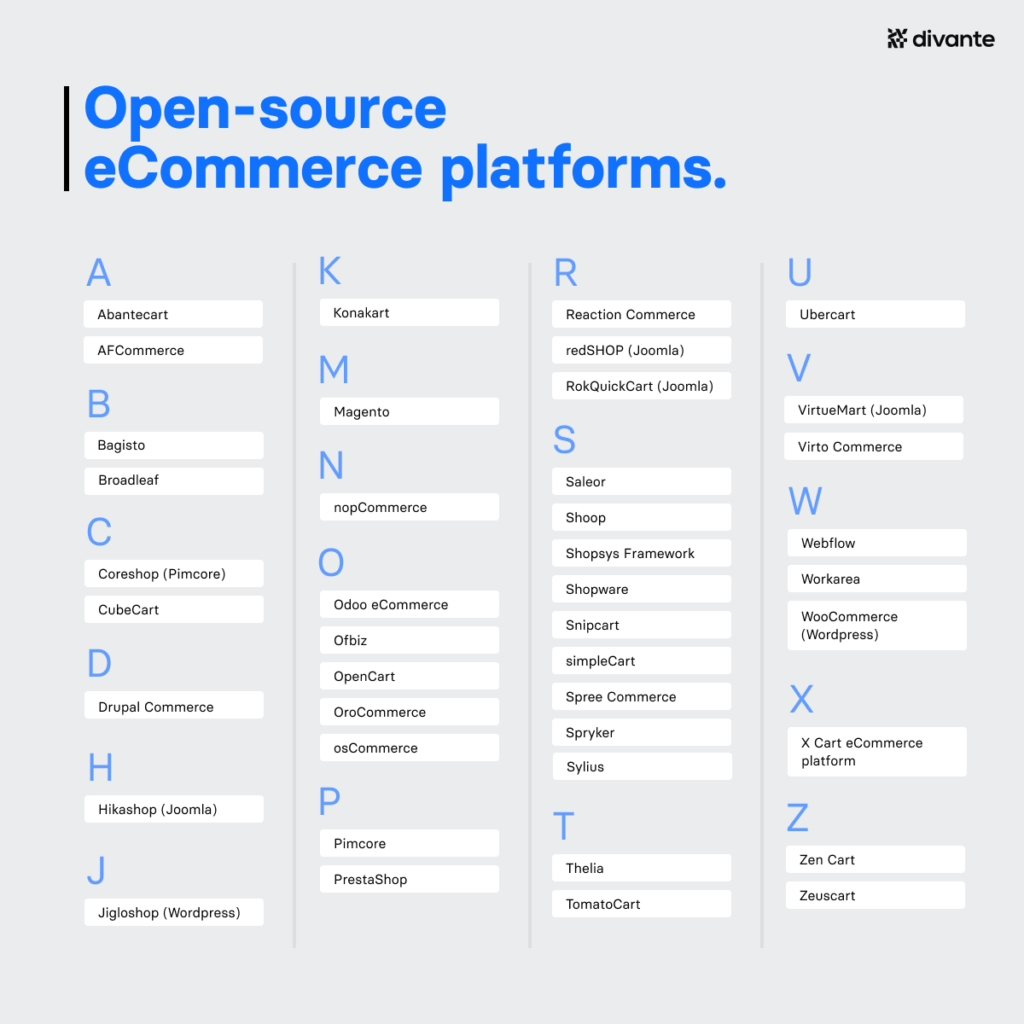
If you are thinking of building a store with open-source for the first time or looking to switch to a new platform, do your homework. We’re going to look at 15 platforms in more detail but here is a comprehensive list, in alphabetical order, of 40 open-source solutions. They range from world-leading platforms that can cope with a product catalogs running into the millions to simple plug-ins that let individuals set up and start trading a limited range of stock within hours.
15 serious open-source eCommerce platforms
There are a few really good platforms that miss out on this shortlist. We’ve chosen 15 which cover a range of different technologies, store types, and build costs—as well as platforms that need a dedicated development team and others that can be run with minimal tech expertise.
Magento 2 (8.5K GitHub stars, 1.5K contributors)*
Still the most popular e-commerce software in the world—powering over 25% of e-stores, according to Alexa Top 1 Million. For all the issues connected to Magento 1 reaching end of life and the age of some of the technology, Magento boasts a community, range of plug-ins, and customization options that none can fully rival. With enough resources, you can find the developers to build whatever you like.
nopCommerce (4.8K stars, 83 contributors)
Using Microsoft technologies and Windows as an operating system, it’s a familiar face that makes nopCommerce popular to so many stores; however, it’s also a good choice for both security and scalability, as it is a genuine option for both small and large eCommerce.
OpenCart (5.4K stars, 273 contributors)
More advanced than a WordPress plug-in solution—with hundreds of ready-to-use integrations payment systems, deliverers, etc—it enables you to create multiple e-shop instances and has some basic functions which are useful when building B2B solutions. OpenCart powers over 300,000 online stores and has an active community that creates thousands of templates and add-ons.
OroCommerce (125 stars, 164 contributors)
OroCommerce is designed primarily as a B2B eCommerce platform. This flexible solution combines functionalities of CRM and eCommerce. Doing so you can leverage CRM capabilities for Sales & Marketing benefits like managing sales pipelines, building detailed marketing segments, and gaining a 360-degree view of the customer.
Pimcore (1.8K stars, 252 contributors)
It’s a dynamically evolving digital platform based on PHP. We see huge potential in combining CMS, PIM, DAM, and eCommerce functions together. This could be an ideal connection for fashion brands and for B2B Manufacturers. While Pimcore itself is not a strict eCommerce platform, there are also interesting dedicated projects like CoreShop.
PrestaShop (4.6K stars, 602 contributors)
Especially popular in Europe, PrestaShop has been live since 2008 and powers over 300,000 e-stores. Like its predecessors, it has been created in PHP, but is differentiated by the ability to handle digital products. We have made a few implementations using PrestaShop, with no significant problems.
Reaction Commerce (10.1K stars, 145 contributors)
Reaction Commerce is a fast, scalable, real-time reactive, and open-source Node.js commerce platform. It plays nicely with npm and Docker, and is based entirely on HTML, CSS, and JavaScript. Among the newest technological stacks presented here.
Saleor (7.6K stars, 148 contributors)
Built on a Django framework, using Python and GraphQL, Saleor taps into the popularity of its tech stack and is constantly gaining GitHub stars from developers. Another platform that has gone headless and offers flexibility to midsize and enterprise clients.
Shopware (1.1K stars, 242 contributors)
Shopware originated in Germany and has quickly gained exposure on the international market. It is similar to some of the better features of Magento, and they also have an open-source and commercial license and an expanding network of partners. Building with Symfony, they focus on flexibility and businesses that are looking to adapt and grow.
simpleCart(js) (1.7K stars, 15 contributors)
It’s an interesting alternative when you need to start an e-shop quickly, and run smoothly, even allowing for large expected increases in traffic. Quoting its authors: “No databases, no programming, no headaches. A simple javascript shopping cart that you can set up in minutes.”
Spree Commerce (10.3K stars, 794 contributors)
The first popular e-commerce platform in RoR, Spree is quickly gaining popularity as a platform for growing stores. Over 50,000 clients are using the solution—including some famous brands like Bonobos and Casper—and they can already boast over a million downloads. Takes a mobile-first approach that speaks our language.
Spree Commerce and Vue Storefront. An integration for uncompromising mobile users. Read the full story
Spryker
Spryker is a commercial product but the source code is open to the public (“Open Code“). Developers can retrieve the source code on GitHub and evaluate the framework. Spryker and its prior versions are used in 100+ international eCommerce projects. Written in Symfony and billed as a solution for digitizers, upgraders, and innovators.
Sylius (5.8K stars, 561 contributors)
Also based on the Symfony framework, Sylius is test-friendly, suitable for Agile development, and shipped with BDD workflow and tools. This very promising project is developing organically and growing at an impressive rate. It already has more than 8 million package downloads.
VirtueMart
VirtueMart’s market share is shrinking but it is still a popular solution that powers a significant number of eCommerce sites, according to Alexa Top 1 Million. It’s also in the top three software choices for migrations to other platforms. Compatible with Joomla, it is challenged by competitors like redSHOP, RokQuickCart, and Hikashop.
WooCommerce (6K stars, 913 contributors)
A popular, free WordPress extension that enables a basic eCommerce website. Added features come as paid extensions. Billed as a platform for any size of business; it is best for small stores with limited IT resources—especially as finding devs to use WordPress is not a tough task.

Open-source eCommerce platforms at a glance
The size of your business and the technology you want to build with are two key factors to take into account when choosing your eCommerce platform. Our at-a-glance table gives you an overview of what is under the hood of our shortlist and who it is for.
| Name | Selected tech |
Typical business users |
License |
| Magento | PHP, MySQL | Midsize to enterprise |
OSL 3.0 |
| nopCommerce | C#, ASP.NET, MS SQL |
Small to midsize | GPL-3.0 |
| OpenCart | PHP, MySQL | Small to midsize | GPL-3.0 |
| OroCommerce | PHP, Symfony | Small to midsize | OSL 3.0 |
| Pimcore | PHP, Symfony, My SQL |
Midsize to enterprise |
GPL-3.0 |
| PrestaShop | PHP, Symfony, MySQL |
Small business | OSL 3.0 |
| Reaction Commerce |
Node.js, HTML, JavaScript |
Small to midsize | GPL-3.0 |
| Saleor | Python, Django, GraphQL |
Midsize to enterprise |
BSD 3-Clause License |
| Shopware | PHP, Symfony | SMB, growing business |
GNU Affero GPL |
| simpleCart | JavaScript | Small to midsize | MIT / GPL |
| Spree Commerce | Ruby on Rails, REST, GraphQL |
Growing business |
New BSD license |
| Spryker | PHP, Symfony | Enterprise | “Open code” |
| Sylius | PHP, Symfony | Midsize to enterprise |
MIT |
| VirtueMart | PHP, MySQL | Small stores | MIT |
| WooCommerce | PHP, MySQL | Small stores | GPL |
Which is the best eCommerce platform for your store?
Our in-depth knowledge of different platforms comes from years of building and evolving Vue Storefront, the world’s fastest-growing eCommerce frontend. Created in a headless approach, VSF is designed to work with any eCommerce backend; we have official integrations with many of the above platforms, including Magento 2, Magento 1, Spryker, Sylius, CoreShop, Spree, and Shopware, and are approaching near-total coverage.
When choosing the best eCommerce platform with which to integrate Vue Storefront, each client has different demands. The decision may be driven by speed of deployment, cost, inventory size, and a number of other criteria. We’ve chosen 5 solutions which you might consider if your decision is driven by speed, customizability, technology, customer type or developer community, breaking it down category by category.
Time to market
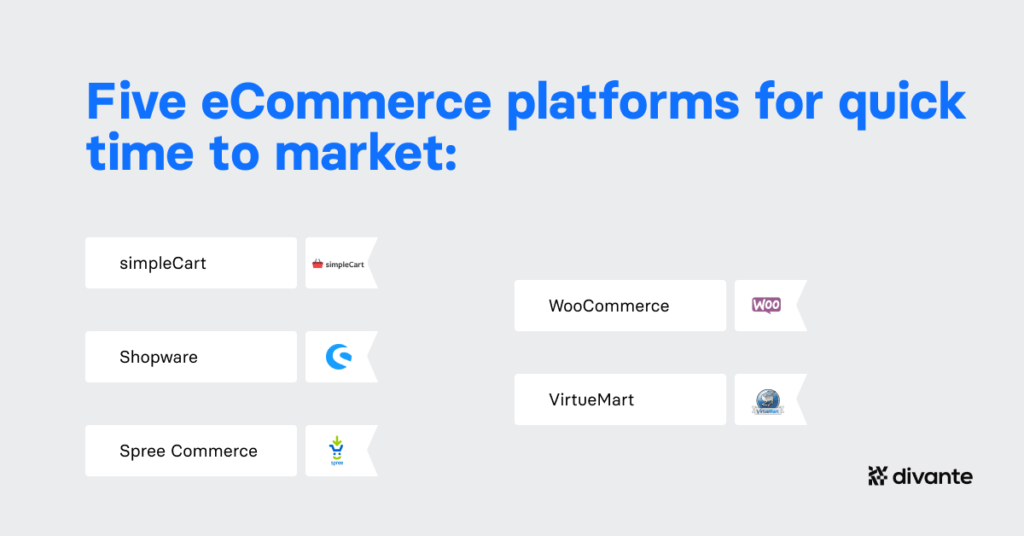
The coronavirus crisis closed the high streets and forced many shops that had limited or no online presence to move sales online… fast. Not only in a crisis, speed to market is a key element that allows you to get the drop on your competitors. Transformation is a dynamic process and one that needs the right technology. For example, Vanella, a New Zealand hospitality equipment provider, realigned its business in just weeks, as a reaction to the COVID-19 crisis, using a Vue Storefront-based PWA frontend to build a store that now sells PPE medical equipment.
Customizability
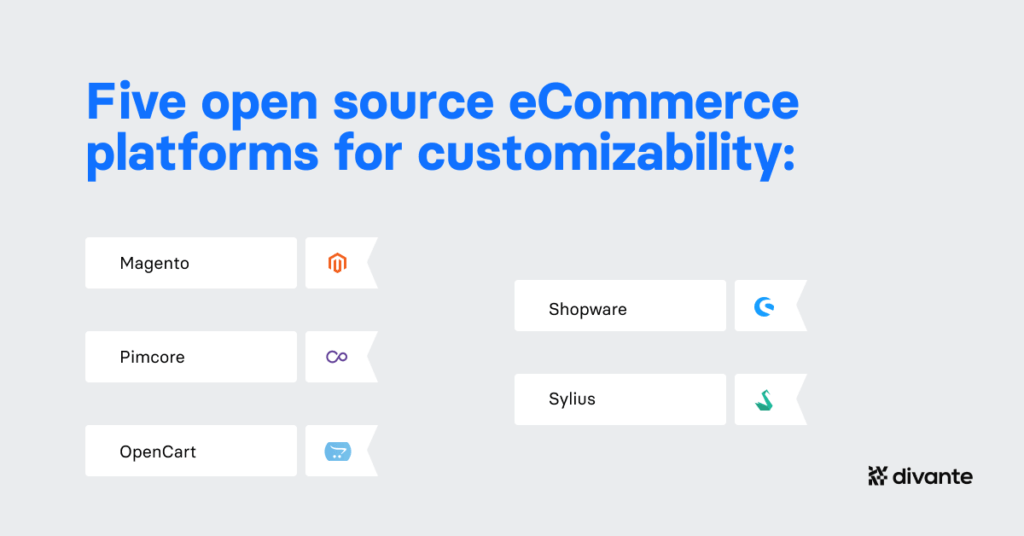
Different products, customers, and geolocations are just some of the factors that require calibration of your online store to the preferred buyer journey. It’s about being able to build whatever you need with whomever you like. Even though Magento has its detractors—and has some well-known underlying issues—the marketplace of third-party extensions means the backend is still more customizable than most other options. The same goes for larger platforms like Pimcore. This backend flexibility is not matched in the frontend, however; and this is what we had in mind when designing Vue Storefront. As a platform-agnostic frontend, it bolts on to any of these large platforms and gives the same frontend freedom that you enjoy in the backend of your e-store.
Kubota, an iconic Polish fashion brand, delivers ultimate flexibility to shoppers and enjoys endless store customization with a mobile-first PWA front end. Read the case study
Tech stack
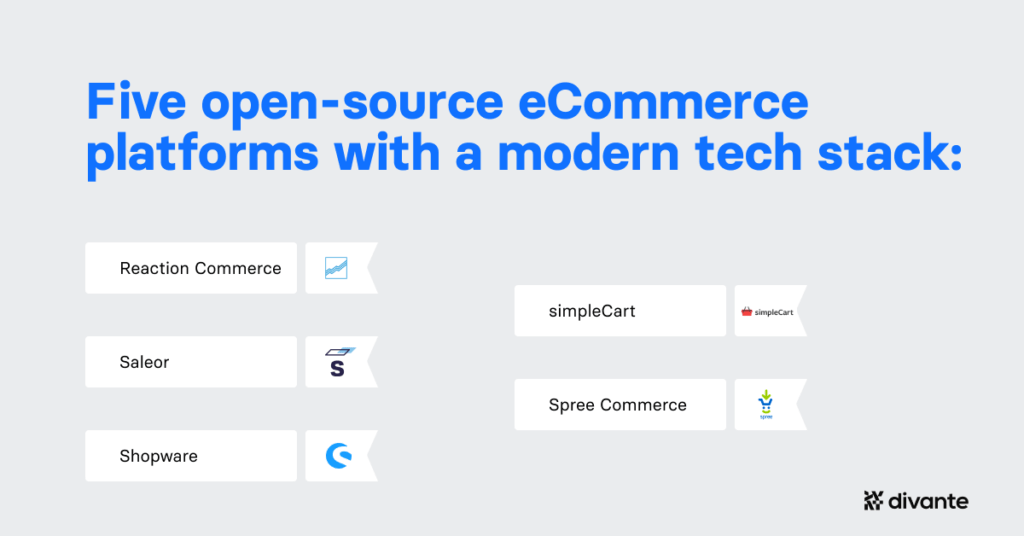
By choosing a tech stack that uses modern technology, you are future-proofing your store. You know that the tools and components that make up your eCommerce will be relevant and high-functioning in the future—unlike legacy technologies. Secondly, you attract better developer talent to build your store. A good rule of thumb is that the best developers are those who are using newer technologies like Python, Ruby, Vue.js, and GraphQL. Also, as a first consideration on the tech stack you choose: if you are not using a headless, mobile-first approach, and are not creating a PWA store, you are not going to be able to deliver modern customer experiences. These have moved beyond being ‘nice-to-have’ features and are now the absolute essentials.
Zadig & Voltaire, a French-based fashion company, rapidly launched a PWA with improved UX for mobile customers to boost revenues coming from online sales. Read more
Customer segment
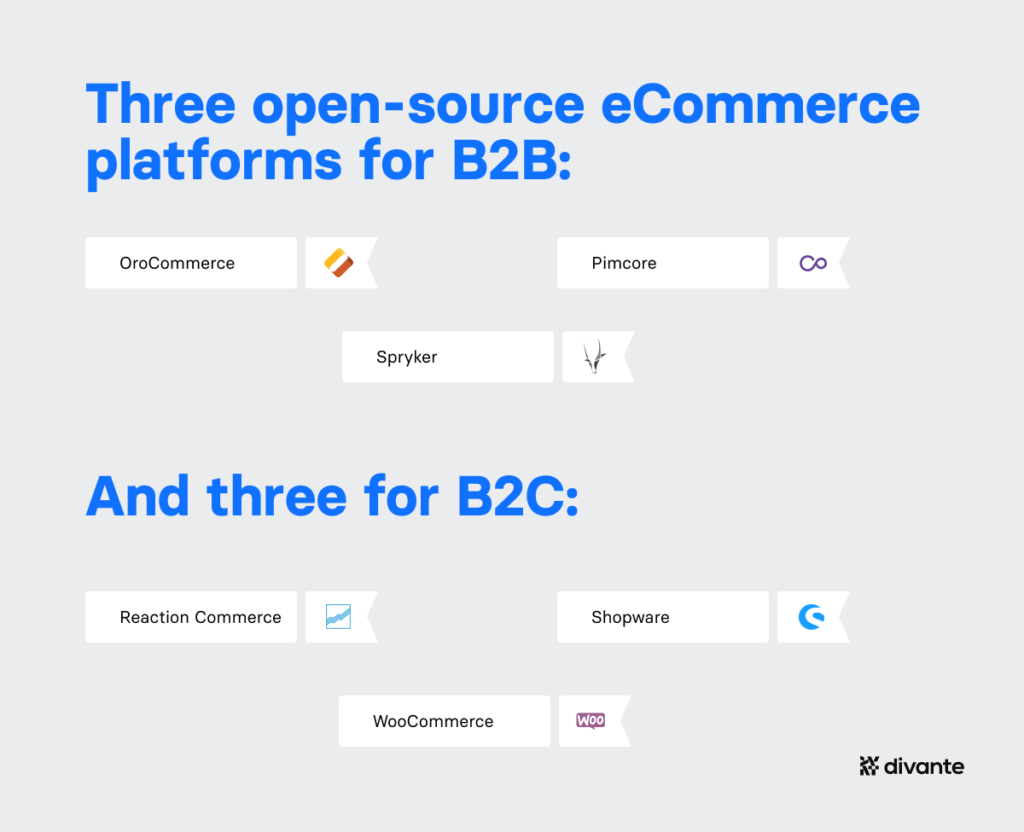
You’ve considered time-to-market, functionality, and technology, but it’s always worth remembering that customers are parting with their money for your products and services. You need to build an eCommerce that fits the inventory you have and the people you sell to. The main segmentation to take into account is whether or not you have B2B or B2C sales channels. Most eCommerce platforms are set up for B2C. They can usually be manipulated to work for B2B operations but it is usually best to choose a platform that is built for the job, such as OroCommerce, Spryker, or Pimcore.
Once you have the right platform, think about if you can adapt your B2B business to the new reality created by COVID-19. The Sales Meeting Hub is a tool that allows you to give remote sales meetings and place orders with your clients live. All done remotely but with face-to-face interaction.
Developer community
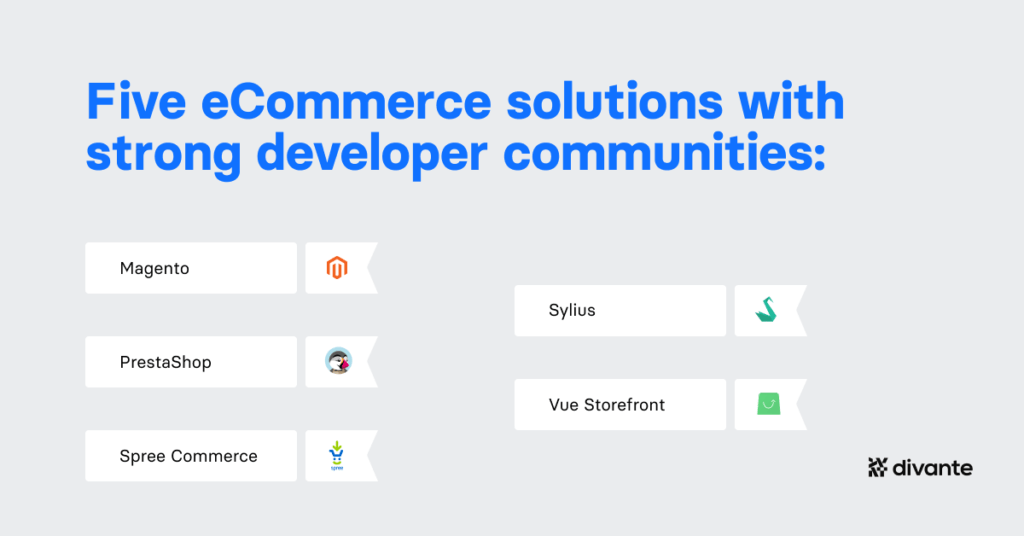
Numbers don’t always tell the full story. However, with open-source projects they are a good indicator of a platform’s popularity and future prospects as the community enhances and maintains the software along with the core development team. There are various ways to measure community engagement, such as the size of the community and responsiveness of core team members on Gitter and Spectrum. The number of Github contributors shows how many people are actively adding their expertise to the code base. A fast growth in Github stars shows that there is a general level of interest in the solution and the technologies it uses.
Open-source contributions are also a good measure of the support for technologies even when the core team are no longer actively involved. Magento 1 may be reached end of life, but the OpenMageProject is a community initiative to keep the legacy version functioning for stores that do not plan to migrate.
We’ve cheated by adding Vue Storefront to this list, as it is a frontend application, not a platform. However, we’ve managed to gather 6,600 stars, 228 contributors and over 2,000 community members on our Slack channel since 2018, so we think it holds its own as a community-driven open-source technology solution.

Article compiled with editorial help from Kaja Grzybowska and technical insight from Filip Rakowski. Graphics by Alina Borowska.
* Statistics for 12 May 2020
Published April 30, 2021







.jpg?width=48&name=unnamed%20(11).jpg)







